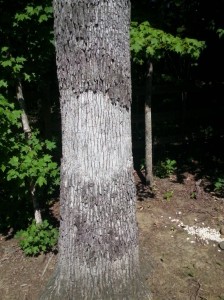Shrub Doctor was recruited by a large church in Huntersville, NC to save the maple trees on their campus. Shrub Doctor identified 72 trees that were suffering from dehydration, lack of nutrition, and advanced infestation of gloomy scale insects. These trees are installed within the small islands of the campus parking areas. Excessive heat and lack of moisture has caused severe decline, requiring several trees to be removed prior to treatment. Shrub Doctor immediately recommended a routine watering schedule to assure proper hydration followed by a three-step restoration treatment. A 1000 gallon watering truck has been acquired by the church to begin a scheduled watering program. Last week Shrub Doctor performed restoration treatments to the trees including deep root fertilization, treatments to kill insect infestations, and treatments to regulate the future growth of the trees. Going forward, the church volunteers will follow Shrub Doctor’s watering and fertilization recommendations to help their trees make a full recovery.
Archive for the ‘Sustainable organic shrub care’ Category
Saving the Lives of Dying Trees
Posted in Around Your Neighborhood, Organic Plant Health, Sustainable organic shrub care, Watering, tagged certified arborist charlotte, Certified ISA arborist, Charlotte arborist, Charlotte tree and shrub care, Charlotte trees, Deep Root Fertilization, Lake Norman Shrubcare, Landscape neglect, Shrub and tree care Charlotte, Shrub Doctor Charlotte on August 2, 2016| Leave a Comment »
Smooth Patch Fungus on Oak
Posted in Around Your Neighborhood, Organic Plant Health, Shrub care, Sustainable organic shrub care, tagged certified arborist charlotte, Certified ISA arborist, Charlotte arborist, Charlotte NC trees, Charlotte shrub care, Charlotte tree and shrub care, Charlotte tree health, Charlotte trees, Deep Root Fertilization, Diseases of shrubs, Organic shrub care Charlotte, Shrub and tree care Charlotte, Shrub Doctor, Shrub Doctor Charlotte on July 22, 2016| Leave a Comment »
 Shrub Doctor noticed a good example of smooth patch fungus activity on this tree today. Also known as white patch, this fungus decomposes the corky outer bark layer of the tree. Since the patch fungus only invades the nonliving outer bark tissues, no harm is done to the tree. Smooth patch is one of many natural occurrences that can be found in our landscapes. No treatments are needed, and your tree should recover over the future seasons. If you notice concerns with your trees and shrubs within your landscape give Shrub Doctor a call. One of our ISA Certified Arborists will be glad to schedule a visit and provide solutions that will keep your plants healthy and vigorous for many years to come.
Shrub Doctor noticed a good example of smooth patch fungus activity on this tree today. Also known as white patch, this fungus decomposes the corky outer bark layer of the tree. Since the patch fungus only invades the nonliving outer bark tissues, no harm is done to the tree. Smooth patch is one of many natural occurrences that can be found in our landscapes. No treatments are needed, and your tree should recover over the future seasons. If you notice concerns with your trees and shrubs within your landscape give Shrub Doctor a call. One of our ISA Certified Arborists will be glad to schedule a visit and provide solutions that will keep your plants healthy and vigorous for many years to come.
Sustainable Planting Technique
Posted in Organic Plant Health, Shrub care, Sustainable organic shrub care, tagged Charlotte shrub care, Charlotte tree and shrub care, Sustainable landscaping, Sustainable organic shrub care on December 21, 2015| Leave a Comment »



 Shrub Doctor recently utilized an old sustainable planting technique when transplanting this 50 year old acuba shrub. The hole was made deep enough to accept several small logs in the bottom. A thin layer of soil was added then watered to fill all the gaps around the logs. The shrub was planted directly on top of the logs. Over time, the logs will absorb and hold water, as well as provide an increased environment of beneficial fungi to the shrub’s root system. This planting practice will allow your shrubs to stay well hydrated during periods of drought. The decaying logs will also provide good organic nutrients for many seasons to come. To learn more about how you can adopt this technique in your landscape give Shrub Doctor a call. Call 1-888-2GO-Organic for more information about our 100% organic shrub and tree fertilization programs.
Shrub Doctor recently utilized an old sustainable planting technique when transplanting this 50 year old acuba shrub. The hole was made deep enough to accept several small logs in the bottom. A thin layer of soil was added then watered to fill all the gaps around the logs. The shrub was planted directly on top of the logs. Over time, the logs will absorb and hold water, as well as provide an increased environment of beneficial fungi to the shrub’s root system. This planting practice will allow your shrubs to stay well hydrated during periods of drought. The decaying logs will also provide good organic nutrients for many seasons to come. To learn more about how you can adopt this technique in your landscape give Shrub Doctor a call. Call 1-888-2GO-Organic for more information about our 100% organic shrub and tree fertilization programs.





